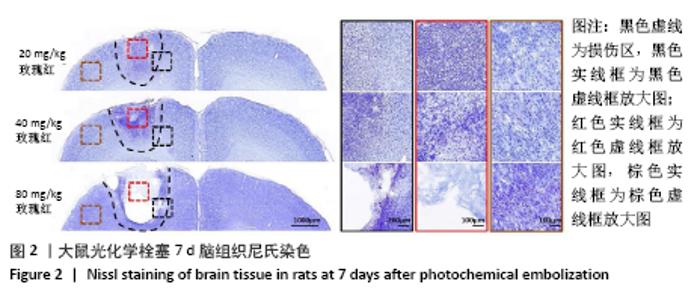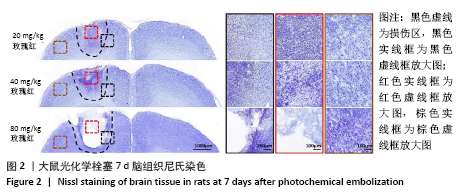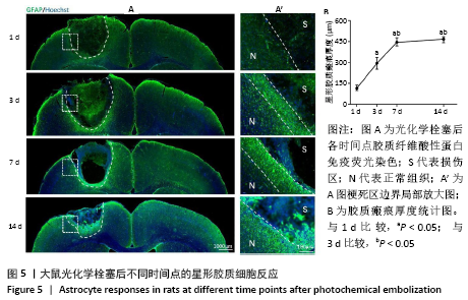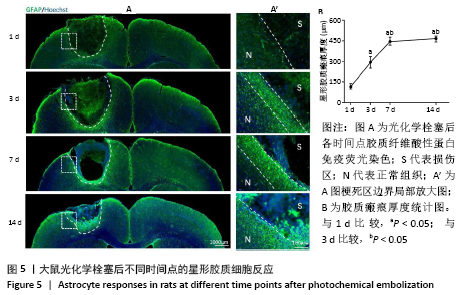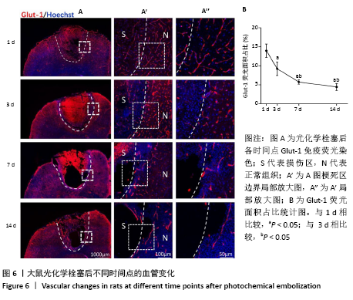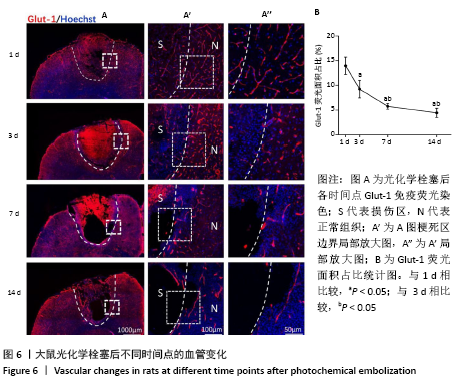Chinese Journal of Tissue Engineering Research ›› 2022, Vol. 26 ›› Issue (2): 218-224.doi: 10.12307/2022.036
Previous Articles Next Articles
Pathological changes in rats with ischemic stroke induced by improved photochemical embolization
Li Shulun1, Hao Peng1, Hao Fei2, Duan Hongmei1, Zhao Wen1, Gao Yudan1, Yang Chaoyang1, Li Xiaoguang1
- 1Department of Neurobiology, School of Basic Medical Sciences, Capital Medical University, Beijing 100069, China; 2Advanced Biomedical Engineering Innovation Center, Medicine & Engineering Innovation Institute, Beihang University, Beijing 100191, China
-
Received:2021-01-21Revised:2021-01-22Accepted:2021-02-05Online:2022-01-18Published:2021-10-27 -
Contact:Li Xiaoguang, MD, Professor, Department of Neurobiology, School of Basic Medical Sciences, Capital Medical University, Beijing 100069, China -
About author:Li Shulun, Master, Department of Neurobiology, School of Basic Medical Sciences, Capital Medical University, Beijing 100069, China -
Supported by:the National Natural Science Foundation of China, No. 81941011, 31730030, 31650001, 31320103903 (all to LXG), 31670988, 31971279 (both to YCY), 31771053 (to DHM), 31900749 (to HP); the National Key Research and Development Program of China, No. 2017YFC1104002 (to YCY) and 2017YFC1104001 (to LXG); Beijing Municipal Science and Technology Plan, No. Z181100001818007 (to YCY); 2018 Science and Technology Plan Key Project of Beijing Municipal Education Commission, No. KZ201810025030 (to YCY); Beijing Natural Science Foundation (Youth Projects), No. 7194243 (to HP) and 7214301 (to HF)
CLC Number:
Cite this article
Li Shulun, Hao Peng, Hao Fei, Duan Hongmei, Zhao Wen, Gao Yudan, Yang Chaoyang, Li Xiaoguang. Pathological changes in rats with ischemic stroke induced by improved photochemical embolization[J]. Chinese Journal of Tissue Engineering Research, 2022, 26(2): 218-224.
share this article
Add to citation manager EndNote|Reference Manager|ProCite|BibTeX|RefWorks
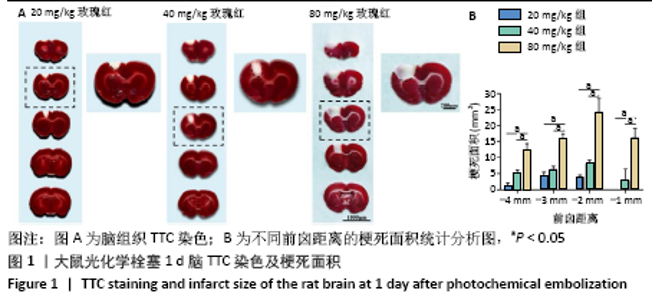
2.1 动物死亡率与造模成功率 实验选用大鼠52只,分为2组,其中46只大鼠制备了光化学栓塞模型,术中死亡2只,其余大鼠在术后恢复良好,存活的44只大鼠均形成了皮质梗死腔,手术模型成功率达到95%;2组共50只大鼠进入结果分析。 2.2 不同浓度梗死范围和区域 为了探索玫瑰红的最优浓度并防止术后的自发恢复,选择了3种浓度进行造模,分别是20,40及80 mg/kg。在光化学栓塞手术后1 d将3组注射不同浓度玫瑰红的大鼠进行TTC染色,见图1,以观察卒中的梗死范围,并对TTC染色后的梗死面积以前囟的距离为分层进行统计[9],梗死面积随着浓度加大而不断加大,在照射轴线最为明显,即前囟前2 mm[20 mg/kg组梗死面积为(4.26±0.58) mm2,40 mg/kg组梗死面积为(6.41±0.47) mm2,均小于80 mg/kg组梗死面积(16.1±0.65) mm2,均P < 0.05]。为了检测长时间点的组织坏死,在7 d时间点对损伤的中心区域进行尼氏染色,见图2,发现给药浓度80 mg/kg的坏死大于 20 mg/kg及40 mg/kg组。为了避免光化学栓塞自发恢复,进而难以追踪到明确的长期病理变化,最终选择80 mg/kg的浓度进行造模。"
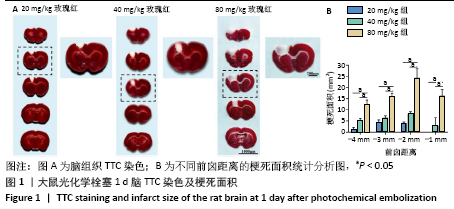
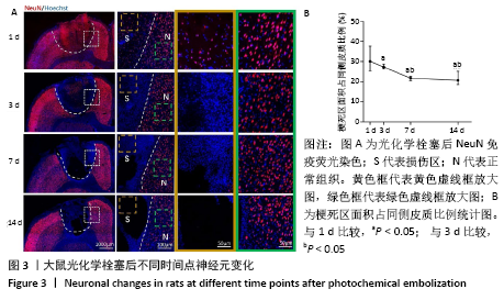
为了探究不同时间点的梗死腔变化,选择NeuN标记神经元,对光化学栓塞后1,3,7,14 d不同时间点的卒中腔中心脑组织进行染色,并统计梗死腔面积占同侧皮质百分比,见图3,随着时间的进展,在1 d时神经元数量减少,开始萎缩,梗死面积占同侧皮质百分比为(30.0±1.7)%;3 d时神经元明显减少,神经元坏死增多,卒中腔开始形成,梗死面积占比为(27.3±0.44)%;7 d时卒中腔内几乎没有神经元存活,并形成局部空腔,梗死面积占比为(21.7±0.3)%,与第3天比较,P < 0.05;14 d时光化学栓塞形成了神经元坏死、空洞形成的明显卒中腔,面积趋于稳定(20.6±1.1)%,与第7天比较, P > 0.05。"
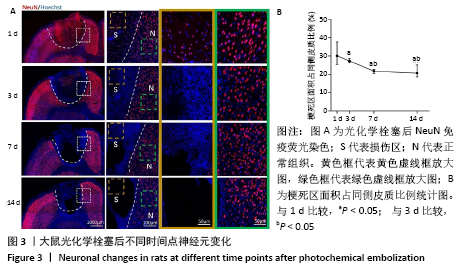
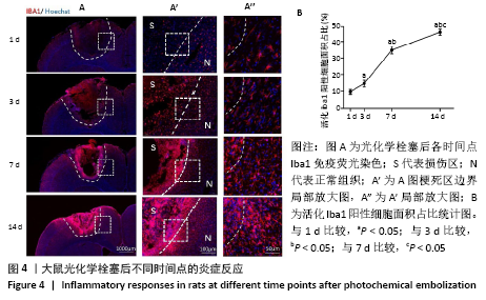
2.3 光化学栓塞后炎症反应及星形胶质细胞反应 为了探究光化学栓塞形成缺血性卒中后的炎症反应及星形胶质细胞反应,利用免疫荧光染色的方式,Iba-1标记小胶质细胞及巨噬细胞。在损伤1 d时,小胶质细胞胞体形态较小,并且未明显聚集于卒中腔周围,炎症反应不明显;3 d时观察到小胶质细胞开始聚集于卒中腔周围;7 d开始小胶质细胞呈现明显活化状态,细胞胞体明显肿胀,突起变短增厚,卒中腔周围iba-1阳性细胞面积占比为(34.8±9)%,14 d时有更大密度的小胶质细胞聚集于卒中腔周围,炎症反应进一步加重,阳性区域达到(45.7±7.5)%,见图4,iba-1阳性细胞面积占比:第7天与第3天比较及第7天与第14天比较,均P < 0.05)。星形胶质细胞形成的瘢痕壁与炎症的进展具有一定相关性,并且会影响卒中腔的范围[10],利用胶质纤维酸性蛋白标记星形胶质细胞,3 d时在卒中腔周围观察到了明显由反应性星形胶质细胞形成的瘢痕壁,并且在7 d时进一步增厚,在7-14 d时,虽然瘢痕壁厚度未明显增加,但反应性星形胶质细胞突起大量的重叠,形成致密瘢痕壁包围卒中腔[瘢痕厚度:第7天(444±18) μm,第14天(466±13) μm,P=0.1],见图5。"
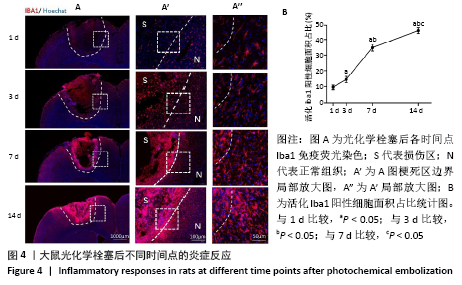
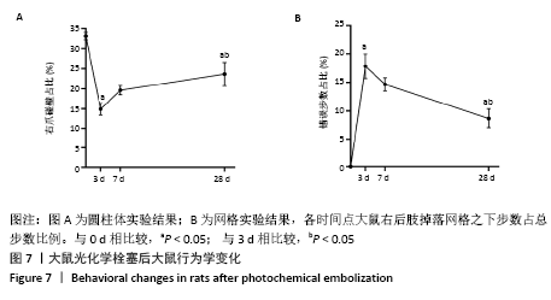
2.5 光化学栓塞后行为学的变化 在圆柱体实验中,光化学栓塞后大鼠右侧(患侧)前肢触壁次数明显减少,并在1个月时间点仍有影响,见图7,大鼠前肢触壁次数:卒中后 3 d(14.9±1.6)%较卒中前(33.1±0.09)%显著减少(P < 0.05),卒中后1个月(23.7±2.9)%明显增加(P < 0.05)。在网格实验中,大鼠的患侧后肢亦会掉落于网格之下,大鼠的错误步数相较于正常组明显增加,见图7,卒中后3 d(17.8±2.1)%较卒中前0%显著增加(P < 0.05),卒中后1个月(8.86±1.69)%显著减少(P < 0.05)。1个月后大鼠前肢碰壁次数和足部错误次数较之前有所恢复,但碰壁实验和网格错误实验在1个月的时间点相比与1 d差异均有显著性意义(P < 0.05),说明光化学栓塞虽然会保留完整的卒中腔,但亦会存在行为学的自发恢复。"
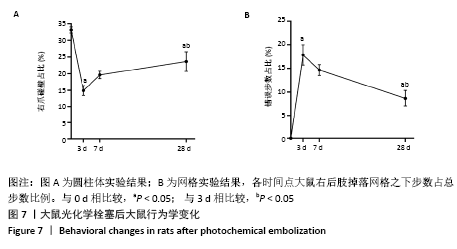
| [1] MEMEZAWA H, MINAMISAWA H, SMITH ML, et al. Ischemic penumbra in a model of reversible middle cerebral artery occlusion in the rat. Exp Brain Res. 1992;89(1):67-78. [2] NEUMANN J, GUNZER M, GUTZEIT HO,et al. Microglia provide neuroprotection after ischemia. FASEB J. 2006;20(6):714-716. [3] TAMURA A, GRAHAM D I, MCCULLOCH J, et al. Focal Cerebral Ischaemia in the Rat: 1. Description of Technique and Early Neuropathological Consequences Following Middle Cerebral Artery Occlusion. J Cereb Blood Flow Metab. 1981;1(1):53-60. [4] MCAULEY MA. Rodent models of focal ischemia.Cerebrovasc Brain Metab Rev. 1995;7(2):153-180. [5] HARRISON TC, SILASI G, BOYD JD, et al. Displacement of sensory maps and disorganization of motor cortex after targeted stroke in mice.Stroke. 2013;44(8):2300-2306. [6] LIU NW, KE CC, ZHAO Y,et al. Evolutional Characterization of Photochemically Induced Stroke in Rats: a Multimodality Imaging and Molecular Biological Study. Transl Stroke Res. 2017;8(3):244-256. [7] CHRISTOPH K, FELIX F, MICHAEL S, et al. Animal models of ischemic stroke and their application in clinical research. Drug Des Devel Ther. 2015;9:3445-3454. [8] IADECOLA C, ANRATHER J.The immunology of stroke: from mechanisms to translation. Nat Med. 2011;17(7):796-808. [9] O’DONNELL ME, TRAN L, LAM TI, et al. Bumetanide Inhibition of the Blood-Brain Barrier Na-K-Cl Cotransporter Reduces Edema Formation in the Rat Middle Cerebral Artery Occlusion Model of Stroke. J Cereb Blood Flow Metab. 2004;24(9):1046-1056. [10] RANSOM BRUCE R, RANSOM CHRISTOPHER B. Astrocytes: multitalented stars of the central nervous system. Methods Mol Biol. 2012;814:3-7. [11] ROSENBLUM WI, EL-SABBAN F. Platelet aggregation in the cerebral microcirculation: effect of aspirin and other agents. Circ Res. 1977; 40(3):320-328. [12] WATSON BD, DIETRICH WD, BUSTO R, et al. Induction of reproducible brain infarction by photochemically initiated thrombosis. Ann Neurol. 1985;17(5):497-504. [13] LEE JK, PARK MS, KIM YS, et al. Photochemically induced cerebral ischemia in a mouse model. Surg Neurol. 2007;67(6):620-625. [14] KUROIWA T, XI G, HUA Y, et al. Development of a rat model of photothrombotic ischemia and infarction within the caudoputamen.Stroke. 2009;40(1):248-253. [15] BACCETTO S L, LEHMANN C. Microcirculatory Changes in Experimental Models of Stroke and CNS-Injury Induced Immunodepression.Int J Mol Sci. 2019;20(20):5184. [16] KLEINSCHNITZ C, BRAEUNINGER S, PHAM M, et al. Blocking of platelets or intrinsic coagulation pathway driven thrombosis does not prevent cerebral infarctions induced by photothrombosis. Stroke. 2008;39(4):1262-1268. [17] KIM HS, KIM D, KIM RG, et al. A rat model of photothrombotic capsular infarct with a marked motor deficit: a behavioral, histologic, and microPET study. J Cereb Blood Flow Metab. 2014;34(4):683-689. [18] SHIH AY, BLINDER P, TSAI PS, et al. The smallest stroke: occlusion of one penetrating vessel leads to infarction and a cognitive deficit. Nat Neurosci. 2013;16(1):55-63. [19] MACREZ R, ALI C, TOUTIRAIS O, et al. Stroke and the immune system: from pathophysiology to new therapeutic strategies. Lancet Neurol. 2011;10(5):471-480. [20] BURDA J, SOFRONIEW M. Reactive Gliosis and the Multicellular Response to CNS Damage and Disease. Neuron. 2014;81(2):229-248. [21] ZHANG W, TIAN T, GONG SX, et al. Microglia-associated neuroinflammation is a potential therapeutic target for ischemic stroke. Neural Regen Res. 2021;16(1):6-11. [22] IADECOLA C, ANRATHER J. The immunology of stroke: from mechanisms to translation. Nat Med. 2011;17(7):796-808. [23] DHEEN ST, KAUR C, LING EA. Microglial Activation and its Implications in the Brain Diseases. Curr Med Chem. 2007;14(11):1189-1197. [24] BROWN GC. Nitric oxide and neuronal death. Nitric Oxide. 2010;23(3): 153-165. [25] RUST R, GRNNERT L, GANTNER C, et al. Nogo-A targeted therapy promotes vascular repair and functional recovery following stroke.Proc Natl Acad Sci U S A. 2019;116(28):14270-14279. [26] NIH LR, GOJGINI S, CARMICHAEL ST, et al. Dual-function injectable angiogenic biomaterial for the repair of brain tissue following stroke.Nat Mater. 2018;17(7):642-651. [27] ANTINA DB, ANNET S, MARICEL GS, et al. Environmental enrichment during the chronic phase after experimental stroke promotes functional recovery without synergistic effects of EphA4 targeted therapy. Hum Mol Genet. 2020;29(4):605-617. [28] PATRICE V, THOMAS ME, MIGUEL CFJ, et al. Dynamic Brains and the Changing Rules of Neuroplasticity: Implications for Learning and Recovery.Front Psychol. 2017;8:1657. [29] JONES TA, JEFFERSON SC. Reflections of experience-expectant development in repair of the adult damaged brain. Dev Psychobiol. 2011;53(5):466-475. [30] HAO P, DUAN H, HAO F, et al. Neural repair by NT3-chitosan via enhancement of endogenous neurogenesis after adult focal aspiration brain injury. Biomaterials. 2017;140:88-102. [31] MO L, YANG Z, ZHANG A, et al. The repair of the injured adult rat hippocampus with NT-3-chitosan carriers.Biomaterials. 2010;31(8): 2184-2192. |
| [1] | Wang Jianping, Zhang Xiaohui, Yu Jinwei, Wei Shaoliang, Zhang Xinmin, Xu Xingxin, Qu Haijun. Application of knee joint motion analysis in machanism based on three-dimensional image registration and coordinate transformation [J]. Chinese Journal of Tissue Engineering Research, 2022, 26(在线): 1-5. |
| [2] | Tan Xinfang, Guo Yanxing, Qin Xiaofei, Zhang Binqing, Zhao Dongliang, Pan Kunkun, Li Yuzhuo, Chen Haoyu. Effect of uniaxial fatigue exercise on patellofemoral cartilage injury in a rabbit [J]. Chinese Journal of Tissue Engineering Research, 2022, 26(在线): 1-6. |
| [3] | Li Huo, Wang Peng, Gao Jianming, Jiang Haoran, Lu Xiaobo, Peng Jiang. Relationship between revascularization and internal microstructure changes in osteonecrosis of the femoral head [J]. Chinese Journal of Tissue Engineering Research, 2022, 26(9): 1323-1328. |
| [4] | Zhang Jichao, Dong Yuefu, Mou Zhifang, Zhang Zhen, Li Bingyan, Xu Xiangjun, Li Jiayi, Ren Meng, Dong Wanpeng. Finite element analysis of biomechanical changes in the osteoarthritis knee joint in different gait flexion angles [J]. Chinese Journal of Tissue Engineering Research, 2022, 26(9): 1357-1361. |
| [5] | Bao Xianguo, Gao Zengxin, Wu Zhanpo, Chen Youmin, Cheng Qinghua, Lu Haitao, Guo Changzheng, Xu Shuai. Correlation between lumbar posterior muscle and local kyphosis in patients with degenerative thoracolumbar kyphosis [J]. Chinese Journal of Tissue Engineering Research, 2022, 26(9): 1418-1423. |
| [6] | Zhang Haobo, Zhao Yunan, Yang Xuejun. Role and therapeutic implications of pyroptosis in intervertebral disc degeneration [J]. Chinese Journal of Tissue Engineering Research, 2022, 26(9): 1445-1451. |
| [7] | Jing Jinpeng, Zhang Yue, Liu Xiaomin, Liu Yi. Traditional Chinese medicine injection for promoting blood circulation in prevention of deep vein thrombosis after orthopedic surgery: network meta-analysis [J]. Chinese Journal of Tissue Engineering Research, 2022, 26(9): 1467-1476. |
| [8] | Zhu Chan, Han Xuke, Yao Chengjiao, Zhang Qiang, Liu Jing, Shao Ming. Acupuncture for Parkinson’s disease: an insight into the action mechanism in animal experiments [J]. Chinese Journal of Tissue Engineering Research, 2022, 26(8): 1272-1277. |
| [9] | Gu Zhengqiu, Xu Fei, Wei Jia, Zou Yongdi, Wang Xiaolu, Li Yongming. Exploratory study on talk test as a measure of intensity in blood flow restriction training [J]. Chinese Journal of Tissue Engineering Research, 2022, 26(8): 1154-1159. |
| [10] | Kong Yamin, Yan Juntao, Ma Bingxiang, Li Huawei. Massage vibration intervenes with MyoD expression and proliferation and differentiation of muscle satellite cells in rats with sciatic nerve injury [J]. Chinese Journal of Tissue Engineering Research, 2022, 26(8): 1160-1166. |
| [11] | Wu Cong, Jia Quanzhong, Liu Lun. Relationship between transforming growth factor beta1 expression and chondrocyte migration in adult articular cartilage after fragmentation [J]. Chinese Journal of Tissue Engineering Research, 2022, 26(8): 1167-1172. |
| [12] | Wang Baojuan, Zheng Shuguang, Zhang Qi, Li Tianyang. Miao medicine fumigation can delay extracellular matrix destruction in a rabbit model of knee osteoarthritis [J]. Chinese Journal of Tissue Engineering Research, 2022, 26(8): 1180-1186. |
| [13] | Lü Yiyan, Li Hanbing, Ma Xiaoqing, Zhang Han, Zhang Yuhang, Li Genlin. Establishment and characteristic analysis of interior heat and diabetes mouse model using compound factors [J]. Chinese Journal of Tissue Engineering Research, 2022, 26(8): 1187-1193. |
| [14] | Li Zhiyi, He Pengcheng, Bian Tianyue, Xiao Yuxia, Gao Lu, Liu Huasheng. Bibliometric and visualized analysis of ferroptosis mechanism research [J]. Chinese Journal of Tissue Engineering Research, 2022, 26(8): 1202-1209. |
| [15] | Xiang Xinjian, Liu Fang, Wu Liangliang, Jia Daping, Tao Yue, Zhao Zhengnan, Zhao Yu. High-dose vitamin C promotes the survival of autologous fat transplantation in rats [J]. Chinese Journal of Tissue Engineering Research, 2022, 26(8): 1242-1246. |
| Viewed | ||||||
|
Full text |
|
|||||
|
Abstract |
|
|||||
